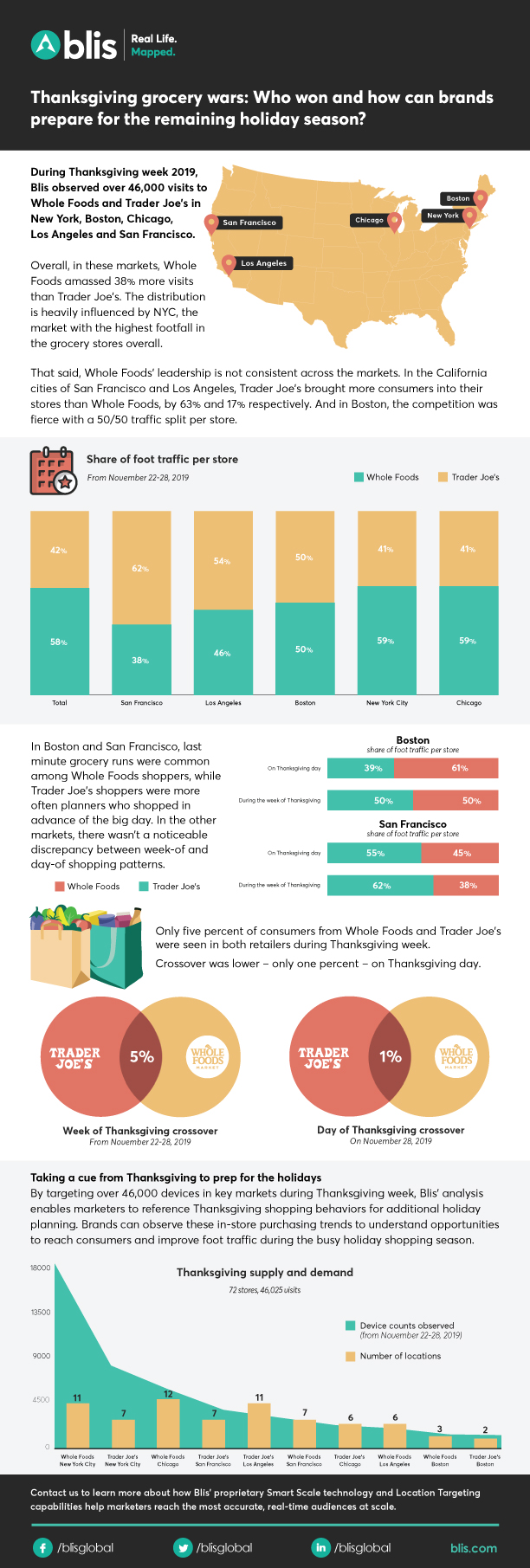Thanksgiving kicks off holiday food shopping for the grocery industry and may serve as an indicator for how the remainder of the holiday food shopping season will go. It’s an important trend to observe, as grocery shopping represents the second-highest holiday spend after gifts. Over the Thanksgiving holiday week, Blis observed grocery shopping trends at Whole Foods and Trader Joe’s stores across major US cities. Our study encompassed over 46,000 visits to stores in New York, Boston, Chicago, Los Angeles and San Francisco.
New York, Boston, Chicago, Los Angeles and San Francisco.
What we discovered is that, from November 22-28, 2019, Whole Foods amassed 38 percent more visits than Trader Joe’s. Because New York represents the market with the highest footfall overall for grocery stores, it did impact the numbers pretty heavily, and Whole Foods’ lead doesn’t carry into every market. Trader Joe’s attracted more customers in California, and the two brands were tied for traffic in Boston.
In Boston and San Francisco, last-minute grocery runs were common among Whole Foods shoppers, while Trader Joe’s shoppers tended to be planners who shopped in advance of the Thanksgiving feast. In the other markets, there wasn’t a noticeable discrepancy between week-of and day-of shopping patterns.
So how can marketers at grocery stores use what we’ve learned to plan for the weeks ahead? There are a few points to observe here, so let’s break them down.
Planners vs. last-minute shoppers
Anyone who’s hosting a holiday dinner will generally plan ahead and purchase in advance things they know they’ll need: a turkey, stuffing, cranberry sauce, etc. However, even the best planner may forget a thing or two, so last minute-mobile ads can impact the bottom line.
With regard to the planners, while many may shop for ingredients, an increasing number of consumers are opting out of cooking and ordering prepared meals instead. Whole Foods reported that they had the most customers to date order turkeys for delivery via AmazonFresh and Prime Now, and that “hundreds of thousands” of prepared holiday meals were purchased from their stores. This should serve as a reminder that an omnichannel strategy is critical for most stores, as – particularly during the busy holiday season – shoppers may want to save time in-store and order their groceries for delivery or curbside pickup.
For those last-minute shoppers, experience is everything. Make their shopping mission as easy as possible. Plan to advertise on the day of and have a holiday shopping section in your store, stock it with the items that people most frequently need: baking soda and powder, sugar, spices, cranberry sauce, stuffing mix, seltzer and tonic water, etc. (This is also important for those folks who ordered their turkeys and other dishes online and are coming to pick them up in-store – they’re going to realize they need more things!).
Different experiences draw different shoppers
For the majority of brands, omnichannel is the way to go, and it’s recommended that grocery stores lean into digital for holiday shopping success. As the countdown to the festive feasts begins, think about geotargeting the neighborhoods around your store, and sending out offers or reminders to pick up napkins, candles, and other easily forgotten items. Target your regular shoppers on social media with quick tips to make their celebrations a little more special, or recommendations for easy gifts for holiday hosts and hostesses. Keep your messages useful and make their shopping experiences as friendly and convenient as possible, and you and your customers will be headed for a warm and wonderful season all around.




